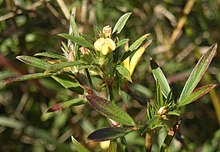
Onobrychis, the sainfoins, are a genus of Eurasian perennial herbaceous plants of the legume family (Fabaceae). About 206 species are presently accepted. The Flora Europaea lists 23 species of Onobrychis; the main centre of diversity extends from Central Asia to Iran, with 56 species – 27 of which are endemic – in the latter country alone. O. viciifolia is naturalized throughout many countries in Europe and North America grasslands on calcareous soils.

In agriculture, rotational grazing, as opposed to continuous grazing, describes many systems of pasturing, whereby livestock are moved to portions of the pasture, called paddocks, while the other portions rest. Each paddock must provide all the needs of the livestock, such as food, water and sometimes shade and shelter. The approach often produces lower outputs than more intensive animal farming operations, but requires lower inputs, and therefore sometimes produces higher net farm income per animal.

Forage is a plant material eaten by grazing livestock. Historically, the term forage has meant only plants eaten by the animals directly as pasture, crop residue, or immature cereal crops, but it is also used more loosely to include similar plants cut for fodder and carried to the animals, especially as hay or silage.

A legume is a plant in the family Fabaceae, or the fruit or seed of such a plant. When used as a dry grain, the seed is also called a pulse. Legumes are grown agriculturally, primarily for human consumption, for livestock forage and silage, and as soil-enhancing green manure. Well-known legumes include beans, soybeans, chickpeas, peanuts, lentils, lupins, grass peas, mesquite, carob, tamarind, alfalfa, and clover. Legumes produce a botanically unique type of fruit – a simple dry fruit that develops from a simple carpel and usually dehisces on two sides.

Trifolium repens, the white clover, is a herbaceous perennial plant in the bean family Fabaceae. It is native to Europe, including the British Isles, and central Asia and is one of the most widely cultivated types of clover. It has been widely introduced worldwide as a forage crop, and is now also common in most grassy areas of North America, Australia and New Zealand. The species includes varieties often classed as small, intermediate and large, according to height, which reflects petiole length. The term 'white clover' is applied to the species in general, 'Dutch clover' is often applied to intermediate varieties, and 'ladino clover' is applied to large varieties.

Macroptilium atropurpureum, commonly referred to as purple bush-bean, or siratro is a perennial legume recognized by its climbing, dense, green vines and deep purple flowers. The plant is indigenous to the tropical and subtropical regions of North, Central, and South America, as far north as Texas in the USA and as far south as Peru and Brazil. It has been introduced for use as a food for stock to many tropical regions around the world. It has become an invasive pest plant in a number of areas, including the north-eastern coast of Australia. Rich in protein, M. atropurpureum is commonly used for cattle pastures intercropped with grass, used in hay, or as a ground cover to prevent soil erosion and to improve soil quality.
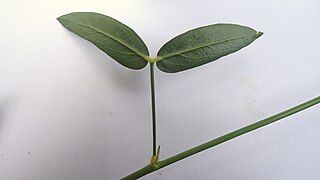
Zornia latifolia is a species of flowering plant in the legume family, Fabaceae. It is native to South America. Its distribution may extend into Central and North America. It is also known as a naturalized species in tropical western Africa. The plant is known commonly as maconha brava.
Bela "Bert" Grof was a Hungarian-born Australian agricultural researcher with contributions to grassland and forage research in the tropics.
Derrick Thomas was a British agricultural researcher with special contributions to grassland and forage research in the tropics.

Urochloa brizantha is a species of grass known by the common name palisade grass. It is often used as a forage for livestock.
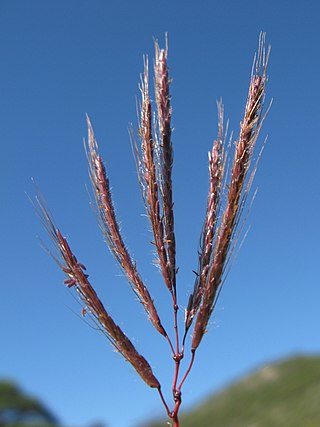
Dichanthium annulatum is a species of grass in the family Poaceae. It is commonly used as a forage for livestock.
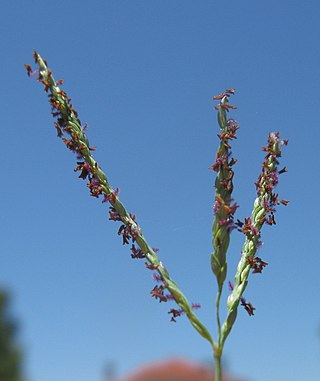
Digitaria didactyla is a species of grass known by the common names blue couch, Queensland blue couch, blue serangoon grass, green serangoon grass, blue stargrass, and petit gazon. It is native to Mauritius, Réunion, parts of mainland Africa, and Madagascar. It has been introduced widely outside its native range, mainly for use as a pasture and turf grass. It has naturalized in some regions.

Alysicarpus vaginalis is a species of flowering plant in the legume family, Fabaceae. It is native to parts of Africa and Asia, and it has been introduced to other continents, such as Australia and the Americas. It is cultivated as a fodder for livestock, for erosion control, and as a green manure. Common names include alyce clover, buffalo clover, buffalo-bur, one-leaf clover, and white moneywort.
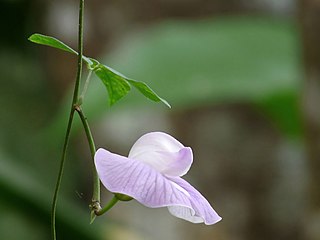
Centrosema pubescens, common name centro or butterfly pea, is a legume in the family Fabaceae, subfamily Faboideae, and tribe Phaseolae. It is native to Central and South America and cultivated in other tropical areas as a forage for livestock.

Chamaecrista rotundifolia, round-leaf cassia, also known as pasto rastiero, roundleaf sensitive pea, and Wynn cassia, is a short-lived perennial or self-generating annual plant in the subfamily Caesalpinioideae of the family Fabaceae. It originated in North America, Mesoamerica, the Caribbean, and Tropical South America but is grown in other parts of the world today. It grows in dry soils and areas of low rainfall, as well as in low-fertility and acidic soils with high levels of solubilized aluminum. It can also reduce erosion and runoff over time. These factors make it a potential asset to farmers in the African Subtropics and elsewhere where soil quality is a barrier to farming. It serves as a source of feed for livestock and acts as a green fertilizer, raising soil quality and nutrient content which can improve yields. These combined benefits make round-leaf cassia a potential solution to many problems faced by poor farmers and their communities.

Centrosema brasilianum belongs to the dicot class with a variety of names such as Clitoria brasiliana, and many more. It is a member of the family Fabaceae. This species in mainly found in South American nations such as Brazil, Guyana, and Bolivia.

Neustanthus is a monotypic genus of flowering plants belonging to the pea family Fabaceae and its tribe Phaseoleae. The only species is Neustanthus phaseoloides, called tropical kudzu. This species is a forage crop and cover crop used in the tropics. It is known as puero in Australia and tropical kudzu in most tropical regions.

Stylosanthes guianensis, the stylo, is a species of flowering plant in the family Fabaceae. It is native to the New World Tropics and Subtropics, and has been introduced to Puerto Rico, the Windward Islands, Trinidad and Tobago, most of Sub‑Saharan Africa, Madagascar, Mauritius, Réunion, Rodrigues, the Indian Subcontinent, Sri Lanka, Thailand, southeast China, Hainan, Taiwan, New Guinea, Queensland, New Caledonia, and the Cook Islands. An important forage and fodder species, its palatability to livestock increases as the plant matures, making it an unusual, and valuable, deferred feed. It has high genetic diversity between and among its named varieties.

Stylosanthes hamata, the Caribbean stylo, is a species of flowering plant in the family Fabaceae. It is native to the islands of the Caribbean, and nearby areas on the mainland; Mexico, Guatemala, Costa Rica, Colombia, and Venezuela, and it has been introduced as a forage crop to Florida, Peru, Brazil, the Gambia, Burkina Faso, Benin, India, Thailand, Hainan, and northern Australia. There are diploid and tetraploid cultivars, with the tetraploids being more drought tolerant and more frequently sown for pasture.

Stylosanthes scabra, the shrubby stylo, is a species of flowering plant in the family Fabaceae, native to tropical South America, and introduced to Hawaii and Australia. It is widely planted as a drought‑tolerant livestock forage.
